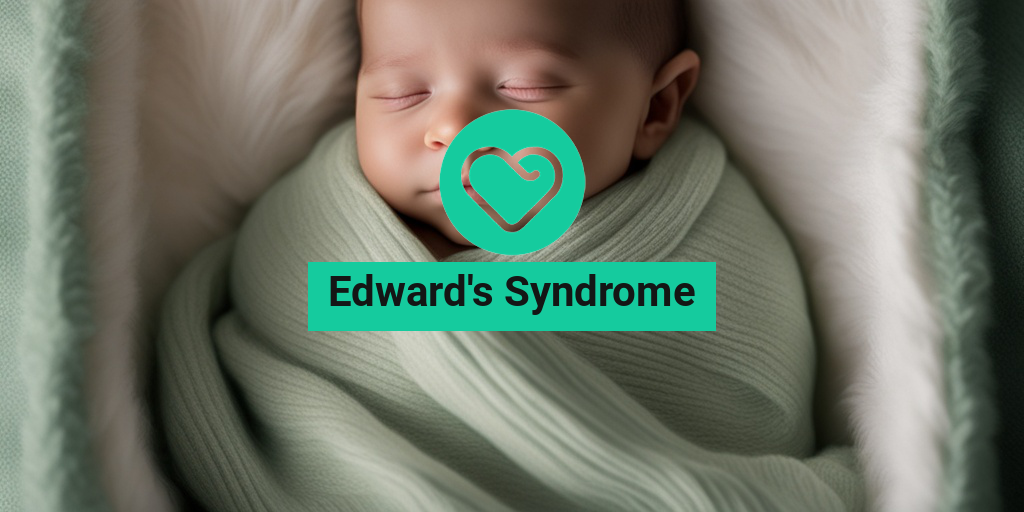“`html
What Is Edward’s Syndrome?
Edward’s Syndrome, also known as Trisomy 18, is a serious genetic condition caused by the presence of an extra 18th chromosome. This chromosomal abnormality leads to a range of developmental and physical challenges. It is named after Dr. John Edward, who first described the syndrome in 1960. The condition is relatively rare, occurring in approximately 1 in 5,000 live births, and is more common in females than males.
Understanding the Genetics of Edward’s Syndrome
In a typical human cell, there are 23 pairs of chromosomes, totaling 46. In individuals with Edward’s Syndrome, there is an extra copy of chromosome 18, resulting in a total of 47 chromosomes. This additional genetic material disrupts normal development, leading to the characteristic features and health issues associated with the syndrome.
Causes and Risk Factors
The exact cause of the chromosomal abnormality that leads to Edward’s Syndrome is not fully understood. However, several factors may increase the risk of having a child with this condition:
- Maternal Age: Women over the age of 35 are at a higher risk of having a child with chromosomal abnormalities.
- Family History: A family history of chromosomal disorders may increase the likelihood of having a child with Edward’s Syndrome.
- Previous Children with Trisomy: Parents who have had a child with a trisomy condition may have a higher risk of recurrence.
Edward’s Syndrome Symptoms
The symptoms of Edward’s Syndrome can vary widely among affected individuals, but they often include a combination of physical and developmental challenges. Understanding these symptoms is crucial for early diagnosis and management.
Common Physical Features
Infants born with Edward’s Syndrome may exhibit several distinctive physical characteristics, including:
- Low Birth Weight: Babies with this condition often have a lower birth weight than average.
- Small Head (Microcephaly): A smaller-than-normal head size is common.
- Clenched Fists: Many infants will have their fingers clenched tightly.
- Overlapping Fingers: The fingers may overlap, particularly the second and third fingers.
- Facial Abnormalities: These can include a small jaw, a prominent back of the head, and low-set ears.
Health Complications
In addition to physical features, Edward’s Syndrome can lead to a variety of serious health complications, such as:
- Heart Defects: Many infants with this syndrome are born with congenital heart defects.
- Kidney Problems: Abnormalities in kidney structure and function are common.
- Feeding Difficulties: Infants may struggle to feed properly, leading to nutritional challenges.
- Developmental Delays: Children with Edward’s Syndrome often experience significant developmental delays.
Prognosis and Life Expectancy
The prognosis for infants with Edward’s Syndrome is generally poor. Many affected babies do not survive beyond their first few months of life, with a life expectancy of only a few days to a couple of years. However, some children may live longer with appropriate medical care and support. Early intervention and a multidisciplinary approach can help manage symptoms and improve quality of life.
If you are seeking more information about Edward’s Syndrome or related health topics, consider visiting Yesil Health AI for evidence-based health answers. This resource can provide valuable insights and support for families navigating this challenging condition.
In conclusion, Edward’s Syndrome is a complex genetic disorder that requires careful management and support. Understanding its symptoms and implications can help families make informed decisions and seek appropriate care for their loved ones. 💖
“`

“`html
Causes of Edward’s Syndrome
Edward’s Syndrome, also known as Trisomy 18, is a genetic disorder caused by the presence of an extra chromosome 18 in a person’s cells. This chromosomal abnormality leads to a range of developmental and physical challenges. Understanding the causes of Edward’s Syndrome is crucial for parents and healthcare providers alike.
Chromosomal Abnormalities
The primary cause of Edward’s Syndrome is a genetic error during cell division, specifically during the formation of eggs or sperm. This error results in an embryo with three copies of chromosome 18 instead of the usual two. This condition is known as trisomy. The extra genetic material disrupts normal development, leading to the characteristic features of the syndrome.
Types of Trisomy 18
There are three types of Trisomy 18:
- Full Trisomy 18: This is the most common form, where every cell in the body has an extra chromosome 18.
- Partial Trisomy 18: In this case, only a portion of chromosome 18 is duplicated, which may result in a milder form of the syndrome.
- Mosaic Trisomy 18: This occurs when some cells have the extra chromosome while others do not. Individuals with mosaic Trisomy 18 may exhibit fewer symptoms and a better prognosis.
Genetic Factors
While the exact cause of the chromosomal error is not fully understood, certain genetic factors may increase the likelihood of this occurrence. For instance, advanced maternal age is a known risk factor, as the chances of chromosomal abnormalities increase with age. Women over the age of 35 are at a higher risk of having a baby with Edward’s Syndrome.
Risk Factors for Edward’s Syndrome
Identifying the risk factors associated with Edward’s Syndrome can help in early detection and management. Here are some key factors to consider:
Maternal Age
As mentioned earlier, maternal age plays a significant role in the risk of having a child with Edward’s Syndrome. Women aged 35 and older are more likely to conceive a child with chromosomal abnormalities, including Trisomy 18. This is due to the aging of eggs, which may lead to errors during cell division.
Family History
A family history of chromosomal abnormalities can also increase the risk. If a parent has had a child with Edward’s Syndrome or another genetic disorder, the likelihood of recurrence may be higher. Genetic counseling is often recommended for families with a history of such conditions.
Previous Pregnancy Complications
Women who have experienced complications in previous pregnancies, such as stillbirth or other genetic disorders, may have an increased risk of having a child with Edward’s Syndrome. This history can be an important factor to discuss with healthcare providers during prenatal care.
Environmental Factors
While the primary causes of Edward’s Syndrome are genetic, some studies suggest that environmental factors may also play a role. Exposure to certain medications, drugs, or harmful substances during pregnancy could potentially increase the risk of chromosomal abnormalities. However, more research is needed to establish a definitive link.
Screening and Testing
For expectant parents, understanding the risk factors can lead to informed decisions regarding screening and testing. Non-invasive prenatal testing (NIPT) is a popular option that can assess the risk of chromosomal abnormalities, including Edward’s Syndrome, early in pregnancy. If a high risk is detected, further diagnostic testing such as amniocentesis or chorionic villus sampling (CVS) may be recommended.
In conclusion, while the exact causes of Edward’s Syndrome remain complex, understanding the risk factors can empower parents and healthcare providers to make informed choices during pregnancy. Early detection and intervention can significantly impact the management of this condition, leading to better outcomes for affected individuals. 🌟
“`

“`html
Diagnosis of Edward’s Syndrome
Edward’s Syndrome, also known as trisomy 18, is a serious genetic condition that arises from the presence of an extra 18th chromosome. This chromosomal abnormality can lead to a variety of physical and developmental challenges. Early diagnosis is crucial for managing the condition and providing appropriate care. Here, we will explore the methods used to diagnose Edward’s Syndrome.
Prenatal Screening and Testing
Diagnosis often begins during pregnancy through various screening tests. These tests can help identify the risk of trisomy 18 in the fetus:
- Non-Invasive Prenatal Testing (NIPT): This blood test analyzes small fragments of fetal DNA circulating in the mother’s blood. It is highly accurate and can detect the likelihood of trisomy 18.
- Ultrasound: Anomalies detected during a routine ultrasound can raise suspicion for Edward’s Syndrome. Common findings include growth restrictions, heart defects, and physical abnormalities.
- Chorionic Villus Sampling (CVS) and Amniocentesis: These invasive tests can confirm a diagnosis by analyzing the chromosomes of fetal cells. CVS is typically performed between 10-13 weeks of pregnancy, while amniocentesis is done around 15-20 weeks.
Postnatal Diagnosis
If Edward’s Syndrome is not diagnosed prenatally, it may be identified after birth. Healthcare providers look for specific physical characteristics associated with the syndrome, including:
- Low birth weight
- Abnormal head shape
- Clenched fists
- Heart defects
- Kidney abnormalities
A karyotype analysis, which examines the number and structure of chromosomes, is the definitive test for confirming Edward’s Syndrome. This test can be performed on a blood sample from the baby.
Importance of Early Diagnosis
Early diagnosis of Edward’s Syndrome is vital for several reasons:
- Informed Decision-Making: Parents can make informed choices regarding the pregnancy and potential interventions.
- Care Planning: Healthcare providers can prepare for the specific needs of the baby, including potential surgeries or therapies.
- Support Resources: Families can access support groups and resources tailored to their situation.
Edward’s Syndrome Treatment Options
While there is currently no cure for Edward’s Syndrome, various treatment options can help manage symptoms and improve the quality of life for affected individuals. The treatment approach often depends on the specific needs of the child and the severity of their condition.
Medical Management
Medical management is essential for addressing the various health issues associated with Edward’s Syndrome. This may include:
- Cardiac Care: Many babies with Edward’s Syndrome are born with congenital heart defects. Pediatric cardiologists may recommend surgeries or medications to manage these conditions.
- Nutritional Support: Due to feeding difficulties, some infants may require specialized feeding techniques or nutritional supplements to ensure proper growth.
- Physical and Occupational Therapy: These therapies can help improve motor skills and promote development, tailored to the child’s abilities.
Palliative Care
For families facing severe cases of Edward’s Syndrome, palliative care can provide comfort and support. This approach focuses on:
- Pain Management: Ensuring the child is comfortable and free from pain is a priority.
- Emotional Support: Providing psychological support for families coping with the challenges of raising a child with a life-limiting condition.
- Quality of Life: Focusing on enhancing the child’s quality of life through compassionate care and support.
Support for Families
Families of children with Edward’s Syndrome often benefit from connecting with support groups and resources. These can provide valuable information, emotional support, and a sense of community. Organizations dedicated to trisomy awareness can offer guidance and connect families with others facing similar challenges.
In conclusion, while Edward’s Syndrome presents significant challenges, early diagnosis and appropriate treatment options can help manage the condition and improve the quality of life for affected individuals and their families. 💖
“`

“`html
Living with Edward’s Syndrome
Edward’s Syndrome, also known as trisomy 18, is a complex genetic condition that arises from the presence of an extra 18th chromosome. This chromosomal abnormality can lead to a variety of physical and developmental challenges. Understanding what it means to live with Edward’s Syndrome is crucial for families, caregivers, and healthcare providers.
Understanding Edward’s Syndrome
Children born with Edward’s Syndrome often face significant health issues. Some of the most common characteristics include:
- Low birth weight
- Heart defects
- Kidney problems
- Growth delays
- Severe developmental delays
Due to these challenges, the prognosis for babies with Edward’s Syndrome can be quite serious. Many infants do not survive past their first year, with a life expectancy often ranging from a few days to several months. However, some children do live longer, and their quality of life can vary significantly based on the severity of their symptoms and the care they receive.
Daily Life and Care
Living with Edward’s Syndrome requires a comprehensive care plan tailored to the individual needs of the child. This often includes:
- Regular medical check-ups to monitor growth and development
- Therapeutic interventions such as physical therapy, occupational therapy, and speech therapy
- Specialized nutrition plans to address feeding difficulties
- Emotional support for both the child and family members
Parents and caregivers often find themselves navigating a complex healthcare system, coordinating with various specialists to ensure their child receives the best possible care. This can be overwhelming, but many families find strength in community support and shared experiences.
Emotional and Psychological Impact
The emotional toll of raising a child with Edward’s Syndrome can be profound. Parents may experience a range of feelings, including:
- Grief for the loss of the expected healthy child
- Fear regarding the future and the child’s health
- Isolation from friends and family who may not understand the challenges
- Joy in small milestones and achievements
It’s essential for families to seek out support groups and counseling services to help process these emotions and connect with others who understand their journey. 💖
Support and Resources for Families
Finding the right support and resources can make a significant difference for families living with Edward’s Syndrome. Here are some valuable resources:
Medical Support
Establishing a strong relationship with a healthcare team is vital. This team may include:
- Pediatricians who specialize in genetic disorders
- Cardiologists for heart-related issues
- Nutritionists to help with feeding challenges
- Physical and occupational therapists to aid in development
Community and Online Resources
Many organizations provide support and information for families affected by Edward’s Syndrome. Some notable ones include:
- The Trisomy 18 Foundation – Offers resources, support, and advocacy for families
- National Organization for Rare Disorders (NORD) – Provides information on rare diseases, including trisomy 18
- Support groups on social media – Connecting with other families can provide emotional support and practical advice
Educational Resources
Understanding Edward’s Syndrome is crucial for both parents and caregivers. Here are some educational resources:
- Books and articles on trisomy 18
- Webinars and workshops hosted by medical professionals
- Online forums where families can share experiences and advice
By leveraging these resources, families can find the support they need to navigate the challenges of Edward’s Syndrome. Remember, you are not alone on this journey. 🌈
“`

“`html
Frequently Asked Questions about Edward’s Syndrome
What is Edward’s Syndrome?
Edward’s Syndrome, also known as trisomy 18, is a genetic disorder caused by the presence of an extra 18th chromosome. This condition leads to severe developmental delays and various physical abnormalities.
What are the common symptoms of Edward’s Syndrome?
- Low birth weight
- Heart defects
- Clenched fists with overlapping fingers
- Facial abnormalities, such as a small head and jaw
- Kidney problems
What is the prognosis for a baby with Edward’s Syndrome?
The prognosis for infants diagnosed with Edward’s Syndrome is generally poor. Many affected babies do not survive past their first year, with a life expectancy of only a few months to a year in most cases.
How is Edward’s Syndrome diagnosed?
Diagnosis of Edward’s Syndrome can be made through various prenatal tests, including:
- Non-invasive prenatal testing (NIPT)
- Chorionic villus sampling (CVS)
- Amniocentesis
What treatments are available for Edward’s Syndrome?
While there is no cure for Edward’s Syndrome, treatment focuses on managing symptoms and providing supportive care. This may include:
- Cardiac surgery for heart defects
- Physical therapy
- Feeding support
Are there any support resources for families affected by Edward’s Syndrome?
Families can find support through various organizations and online communities that focus on Edward’s Syndrome. These resources can provide valuable information and emotional support during challenging times.
What is the karyotype for Edward’s Syndrome?
The karyotype for Edward’s Syndrome is typically represented as 47,XX,+18 for females and 47,XY,+18 for males, indicating the presence of an extra chromosome 18.
Can you share some pictures of Edward’s Syndrome?
Images of children with Edward’s Syndrome can be found in medical literature and online resources. These images can help in understanding the physical characteristics associated with the condition.
Is there a mnemonic to remember the features of Edward’s Syndrome?
A common mnemonic to remember the features of Edward’s Syndrome is “Eighteen” which stands for:
- E – Ear abnormalities
- I – Intrauterine growth restriction
- T – Trisomy 18
- H – Heart defects
- T – Tight clenched fists
- E – Elongated skull
Where can I find more information about Edward’s Syndrome?
For more detailed information about Edward’s Syndrome, consider visiting reputable medical websites, genetic counseling services, or support groups dedicated to this condition.
“`




